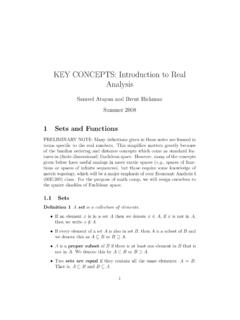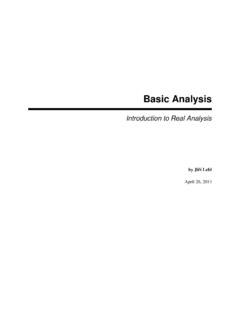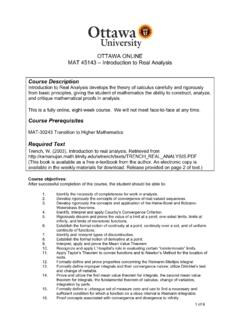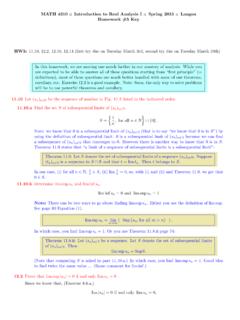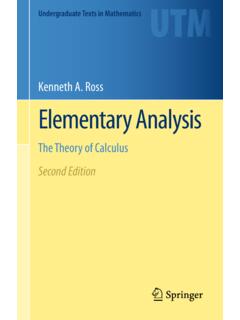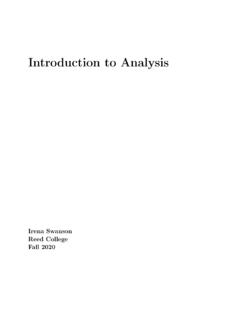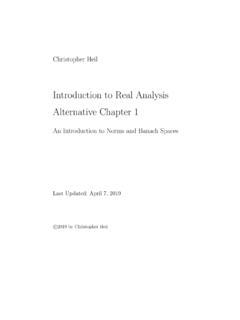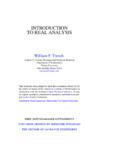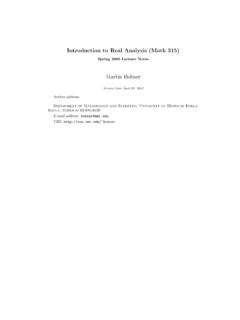Transcription of Second edition Richard F. Bass
1 Real analysis for graduatestudentsSecond editionRichard F. Bassiic Copyright 2013 Richard F. BassAll rights : 978-1481869140 ISBN-10: 1481869140 First edition published the memory of my parentsJay and Betty BassivContentsPrefacexiii1 and terminology .. undergraduate mathematics ..22 Families of and -algebras .. monotone class theorem ..113 and examples ..164 Construction of measures .. measures .. and related results .. sets .. Carath eodory extension theorem ..34vviCONTENTS5 Measurable .. of functions .. s theorem ..446 The Lebesgue ..497 Limit convergence theorem .. of the integral .. s lemma .. convergence theorem ..568 Properties of Lebesgue for a function to be zero .. approximation result ..669 Riemann with the Lebesgue integral ..7110 Types of Definitions and examples .. Exercises ..78 CONTENTSvii11 Product Product -algebras.
2 The Fubini theorem .. Examples .. Exercises ..8812 Signed Positive and negative sets .. Hahn decomposition theorem .. Jordan decomposition theorem .. Exercises ..9713 The Radon-Nikodym Absolute continuity .. The main theorem .. Lebesgue decomposition theorem .. Exercises ..10414 Maximal functions .. Antiderivatives .. Bounded variation .. Absolutely continuous functions .. Approach 2 differentiability .. Approach 2 antiderivatives .. Approach 2 absolute continuity .. Exercises .. Norms .. Completeness .. Convolutions .. Bounded linear functionals .. Exercises ..14116 Fourier Basic properties .. The inversion theorem .. The Plancherel theorem .. Exercises ..15517 Riesz Partitions of unity .. The representation theorem .. Regularity .. Bounded linear functionals.
3 Exercises ..16718 Banach Definitions .. The Hahn-Banach theorem .. Baire s theorem and consequences .. Exercises ..17819 Hilbert Inner products .. Subspaces .. Orthonormal sets .. Fourier series .. Exercises ..194 CONTENTSix20 Definitions .. Compactness .. Tychonoff s theorem .. Compactness and metric spaces .. Separation properties .. Urysohn s lemma .. Tietze extension theorem .. Urysohn embedding theorem .. Locally compact Hausdorff spaces .. Stone- Cech compactification .. Ascoli-Arzel`a theorem .. Stone-Weierstrass theorems .. Connected sets .. Exercises ..24021 Definitions .. Independence .. Weak law of large numbers .. Strong law of large numbers .. Conditional expectation .. Martingales .. Weak convergence .. Characteristic functions .. Central limit theorem.
4 Kolmogorov extension theorem .. Brownian motion .. Exercises ..293xCONTENTS22 Harmonic Definitions .. The averaging property .. Maximum principle .. Smoothness of harmonic functions .. Poisson kernels .. Harnack inequality .. Exercises ..31523 Sobolev Weak derivatives .. Sobolev inequalities .. Exercises ..32224 Singular Marcinkiewicz interpolation theorem .. Maximal functions .. Approximations to the identity .. The Calderon-Zygmund lemma .. Hilbert transform .. Exercises ..34625 Spectral Bounded linear operators .. Symmetric operators .. Compact symmetric operators .. An application .. Spectra of symmetric operators .. Spectral resolution .. Exercises ..37726 Definitions and examples .. Distributions supported at a point .. Distributions with compact support .. Tempered distributions.
5 Exercises ..392xiiCONTENTSP refaceNearly every student in mathematics needs to pass a pre-liminary or qualifying examination in real analysis. The purposeof this book is to teach the material necessary to pass such had three main goals in writing this text:(1) present a very clear exposition;(2) provide a large collection of useful exercises;(3) make the text me discuss each of these in more detail.(1) There are a large number of real analysis texts already inexistence. Why write another? In my opinion, none of the exist-ing texts are ideally suited to the beginning graduate student whoneeds to pass a prelim or qual. They are either too hard, tooadvanced, too encyclopedic, omit too many important topics, ortake a nonstandard approach to some of the basic who are starting their graduate mathematics educa-tion are often still developing their mathematical sophistication andfind that the more details that are provided, the better (within rea-son).
6 I have tried to make the writing as clear as possible and toprovide the details. For the sake of clarity, I present the theoremsand results as they will be tested, not in the absolutely most generalabstract context. On the other hand, a look at the index will showthat no topics that might appear on a preliminary or qualifyingexamination are the proofs are plain vanilla. I avoid any clever tricks,sneaky proofs, unusual approaches, and the like. These are theproofs and methods that most experts grew up (2) There are over 400 exercises. I tried to make them inter-esting and useful and to avoid problems that are overly are routine, many are of moderate difficulty, but some arequite challenging. A substantial number are taken from prelimi-nary examinations given in the past at major thought long and hard as to whether to provide hints to theexercises. When I teach the real analysis course, I give hints to theharder questions.
7 But some instructors will want a more challeng-ing course than I give and some a less challenging one. I leave itto the individual instructor to decide how many hints to give.(3) I have on my bookshelf several books that I bought in theearly 1970 s that have the prices stamped in them: $10-$12. Thesevery same books now sell for $100-$200. The cost of living hasgone up in the last 40 years, but only by a factor of 5 or 6, nota factor of 10. Why do publishers make textbooks so expensive?This is particularly troublesome when one considers that nowadaysauthors do their own typesetting and frequently their own aim was to make the soft cover version of this text cost lessthan $20 and to provide a version in .pdf format for free. To dothat, I am self-publishing the this point I should tell you a little bit about the subjectmatter of real analysis. For an interval contained in the real line ora nice region in the plane, the length of the interval or the area ofthe region give an idea of the size.
8 We want to extend the notion ofsize to as large a class of sets as possible. Doing this for subsets ofthe real line gives rise to Lebesgue measure. Chapters 2 4 discussclasses of sets, the definition of measures, and the construction ofmeasures, of which one example is Lebesgue measure on the line.(Chapter 1 is a summary of the notation that is used and thebackground material that is required.)Once we have measures, we proceed to the Lebesgue talk about measurable functions, define the Lebesgue integral,prove the monotone and dominated convergence theorems, look atsome simple properties of the Lebesgue integral, compare it to theRiemann integral, and discuss some of the various ways a sequenceof functions can converge. This material is the subject of Chapters5 tied with measures and integration are the subjects ofproduct measures, signed measures, the Radon-Nikodym theorem,the differentiation of functions on the line, andLpspaces.
9 Theseare covered in Chapters 11 courses in real analysis stop at this point. Others also in-clude some or all of the following topics: the Fourier transform, theRiesz representation theorem, Banach spaces, and Hilbert present these in Chapters 16 and probability are courses in their own right, butthey are something every analyst should know. The basics aregiven in Chapters 20 and 21, 22 26 include a number of topics that are sometimesincluded in examinations at some universities. These topics areharmonic functions, Sobolev spaces, singular integrals, spectraltheory, and first edition of this text, which was titledReal analysisfor graduate students: measure and integration theory, stopped atChapter 19. The main comments I received on the first editionwere that I should cover additional topics. Thus, the Second editionincludes Chapters 20 to 26. This increased the length from around200 pages to around 400 prerequisites to this text are a solid background in un-dergraduate mathematics.
10 An acquaintance with metric spaces isassumed, but no other topology. A summary of what you need toknow is in Chapter 1. All the necessary background material canbe learned from many sources; one good place is the book [7].At some universities preliminary or qualifying examinations inreal analysis are combined with those in undergraduate analysis orcomplex analysis. If that is the case at your university, you willhave to supplement this book with texts in those reading is always useful. I have found the books [4], [6],and [8] would like to thank A. Baldenko, I. Ben-Ari, K. Bharath, , D. Ferrone, E. Gin e, M. Gordina, E. Hsu, G. Lawler, , K. Marinelli, J. Pitman, M. Poehlitz, H. Ren,and L. Rogersfor some very useful suggestions. I would particularly like to thankmy colleague Sasha Teplyaev for using the text in his class andsuggesting innumerable you have comments, suggestions, corrections, etc., I would beglad to hear from I cannot, however,provide hints or solutions to the luck with your exam!


